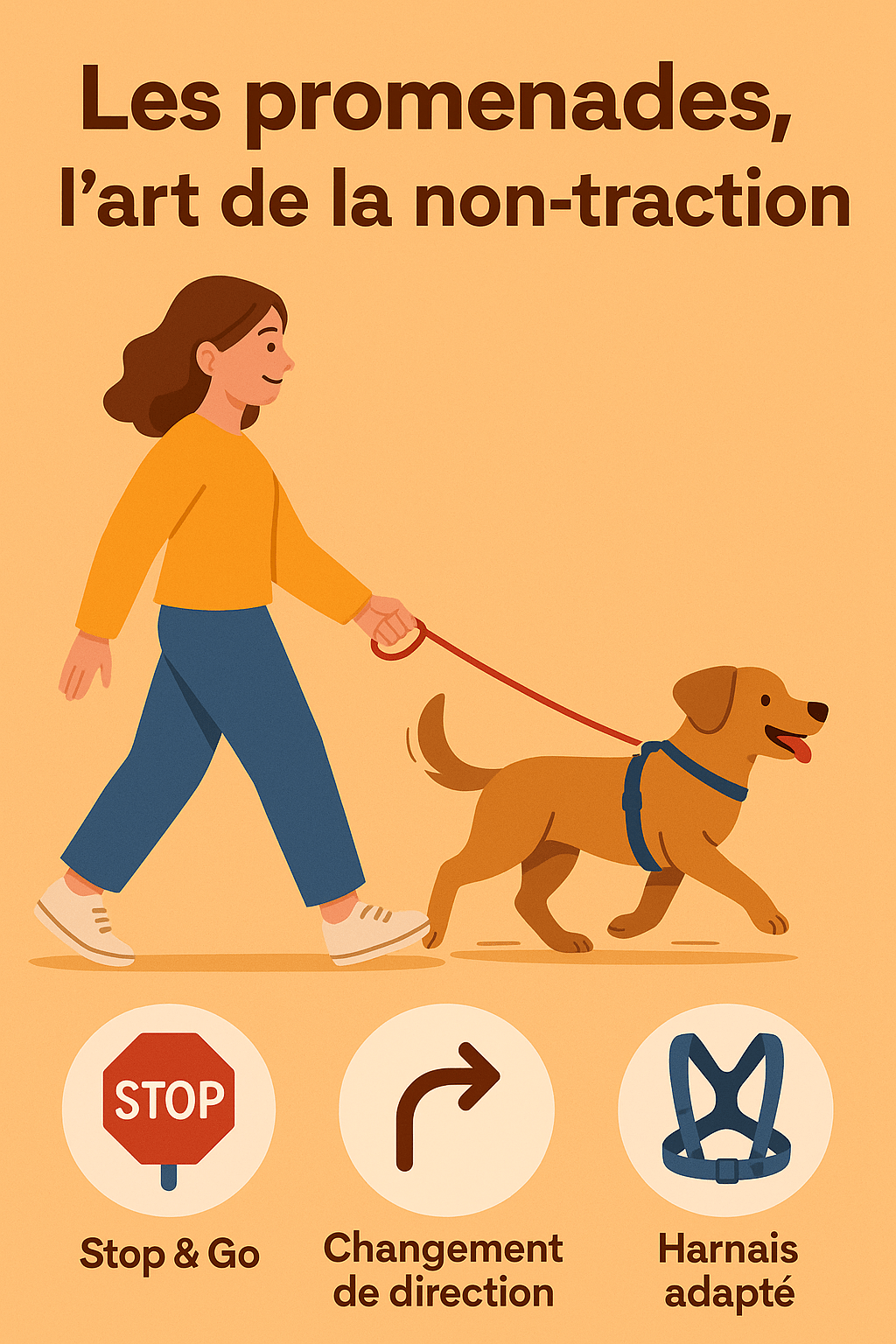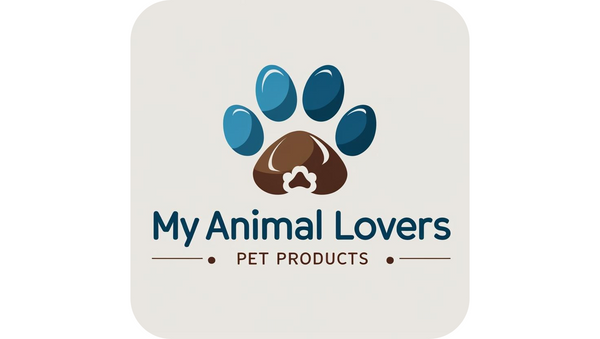
My Dog Pulls on the Leash: The WoofMidable Guide to Relaxed and Complicit Walks
Share
Walks, the art of non-traction
There are two types of owners: those who stroll leisurely with their dog, and those who find themselves competing with Usain Bolt, pulled at high speed by an overexcited quadruped. If you fall into the second category, it's not because you're a bad owner. Far from it! It's simply that your dog, in his great innocence and love of discovery, has misinterpreted the concept of "walking." For him, it's the call of adventure, the need to explore, sniff, and mark his territory. He doesn't yet understand that to move forward, you have to... not pull!
Our mission, should you choose to accept it, is to transform these marathon walks into WoofMidable bonding moments. Together, we'll teach your dog not to think of you as his personal CrossFit coach. Prepare to become a calm master and give your dog the keys to respectful freedom. No more shoulder dislocations and silent howls of frustration!
The Foundations of a Successful Walk
Before we get into the nitty-gritty, it's essential to understand why a dog pulls on the leash. Often, it's a combination of several factors: excitement, lack of basic training, unsuitable equipment, or simply the desire to sniff that bush that looks so interesting. Fortunately, by acting on these different levers, you can work wonders.
1. The "Stop & Go" Principle: The Power of Stillness
This is the simplest trick, but also the most formidable. The moment your dog puts any strain on the leash, you become a statue. Immediately. No negotiation, no "no," just total immobility.
How does it work?
-
Worst case scenario: Your dog spots a squirrel and starts pulling with all his might. Your shoulder is about to dislocate.
-
Your action: Stop, plant your feet on the ground. Don't move. Your dog will continue to pull, be surprised that he's not moving forward, and eventually turn around to face you, as if to say, "Uh... shall we go?"
-
The WoofMidable Reward: As soon as he releases the tension or turns towards you, even for a split second, it's time for magic! Petting, a gentle voice, and most importantly, a little natural treat This is the signal for him: "I understand!". Resume walking.
The Secret of Patience
At first, it will be long. Very long. You will feel like you are going nowhere. But perseverance is key. Always remember: every time you move forward while the leash is taut, you are validating his behavior. He is learning that pulling works. For your dog to learn, he must understand that pulling does absolutely nothing . It may be necessary to stop dozens of times during a single walk. Think about what you want for your dog in the long term. A good 5 meter long line can also be a valuable aid for this exercise, by providing distance while maintaining control.
2. The surprise effect: the change of direction
Does your dog have a fixation point? An overpowering scent he absolutely wants to explore? Before he pulls, change direction. It's a canine version of cat and mouse.
How does it work?
-
The Sniffing Scenario: Your dog heads straight for a lamppost that he absolutely wants to sniff, the leash tightens.
-
Your action: Instead of letting him do it, suddenly turn to the other side. Without shouting or scolding him. The goal is to surprise him and force him to refocus on you. He'll think, "Hey! What's going on? Where am I?"
-
The WoofMidable reward: As soon as he looks at you, leash it relaxed, praise him and give him a little dog treat Repeat this several times. Your dog will understand that it's okay to follow you and that you're the one in charge.
3. Attention, the Holy Grail of the dog owner
Leash pulling is often linked to a lack of attention. For your dog, the outside world is so fascinating that he forgets his favorite star... you! So you need to relearn how to be the center of his universe, even outdoors.
How does it work?
-
Mindful walking: While walking, keep a candy (or a small toy) in hand. As soon as your dog walks calmly beside you, or gives you a furtive glance, reward him immediately.
-
The WoofMidable Reward: The key is surprise. Offer the reward when he least expects it. This creates a positive association: "Walking calmly next to my human is WoofMidable! I get rewards!"
-
Attention games: You can also turn the walk into a little attention game. For example, happily shout "Yes, that's good!" when he looks at you, and give him a little piece of dog sausage He'll love it!
4. The right equipment: the secret weapon
You don't go to war without good weapons, do you? For walks, the secret weapon is the right equipment. Forget collars that pull on the throat (and can hurt your dog).
The harness, your best friend
-
No-pull harness: These harnesses are designed to reduce the urge to pull. The leash attaches to the chest, causing the dog to pivot when it tries to pull. This brings it back towards you, which lets it know there's no point in forcing it. This is a very effective solution, and it's much more comfortable for your dog. You'll find anti-pull harness of all sizes on our webshop.
-
The leash: Avoid leashes that are too short, which create constant tension. medium length leash or long (between 1.50m and 2m) is ideal. It gives your dog room to maneuver without feeling restricted. It's the perfect accessory for gentle learning.
5. Walking to heel: the dance class
Heeling is the advanced version of walking. It's the equivalent of a dance class: you and your dog, in perfect sync. This exercise can be learned from a young age, at home, before moving outside.
How does it work?
-
At home: Start the exercise in a quiet environment. With a treat, ask your dog to walk a few meters beside you. Reward him generously. Repeat the exercise until he understands.
-
Outdoors: On a walk, ask him to heel for a few meters, then release the pressure by saying "Go!", and let him sniff and explore. Then, repeat the exercise. Your dog learns that walking attentively is only a short time before gaining his freedom. For this exercise, a learning lanyard can be very helpful in gaining control while still giving your dog space.
6. Exercise before education
A dog with energy is a dog that pulls. It's a golden rule. If your dog has a habit of thinking you're a drag racer, it may be because he needs to let off steam before even starting the ride.
How does it work?
-
Spending before learning: Before putting on the leash, take your dog to a safe park so he can run, play with toys, and have fun. dog toys or interact with other dogs. This will allow him to release his excess energy. Once he is a little calmer and has done his business, you can begin walking him and learning to walk on a leash.
-
The Anti-Boredom Ball: A ball for distributing kibble It's also a great idea to get him mentally active before the walk. He'll have to think to get his reward, which will tire him out in a healthy way.
Consistency, an essential superpower
Training a dog is a bit like a diet: the slightest deviation can ruin everything. If one day you stop when he pulls and the next day, due to lack of time, you let him do it, your dog will no longer understand anything. He will think that pulling works "sometimes," which is the worst thing that can happen. Be consistent, every time.
Regular walks, a WoofMidable habit
Walks are a time for socialization, exercise, and fun. The more you go on walks, the more your dog will get used to being on a leash and walking by your side. It's also a perfect opportunity to strengthen the bond between you. And don't forget that your dog needs to let off steam. There are a thousand and one ways to make walks more fun: treasure hunts with treats , cuddle breaks, or playtime with your favorite toy .
When to ask for help?
Despite your best efforts and the application of these tips, your dog may still pull excessively. Don't lose hope! Sometimes it's necessary to call in a professional. A dog trainer can observe your interactions, identify potential communication errors, and offer you personalized solutions.
Education, a shared adventure
Hiring a professional isn't an admission of failure; it's a sign of responsibility. It's an investment in your dog's well-being and the peace of mind of your home. A trainer can help you find the ideal equipment, such as a harness or a training leash , and give you specific advice for your dog.
Conclusion: Pleasure rediscovered
In short, dog training is a matter of heart and patience. Perseverance, consistency, and positive reinforcement are the keys to a pleasant and relaxed leash walk. The main thing is to never reward pulling (by moving forward) and to celebrate every little bit of progress your dog makes!
At My Animal Lovers , we are here to support you in this adventure. You will find on our webshop all the essential accessories to make your walks a real pleasure: ergonomic harnesses , of the strong leashes , of the quality treats and WoofMidables toys to reward every success.
So, on your marks, get set, walk!
